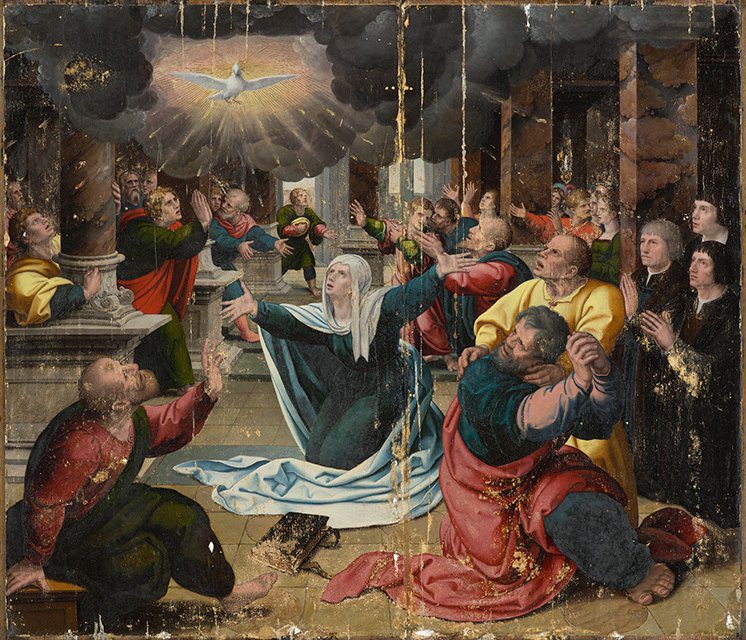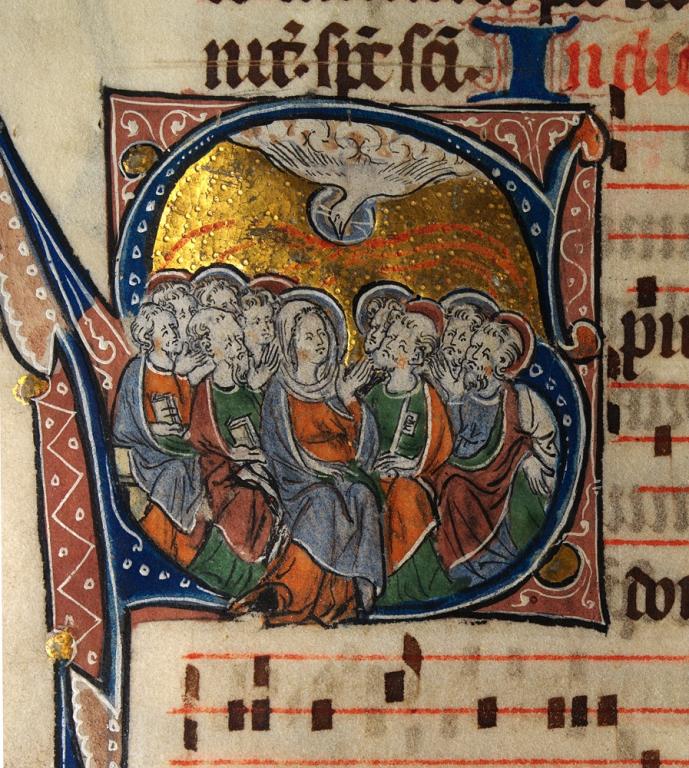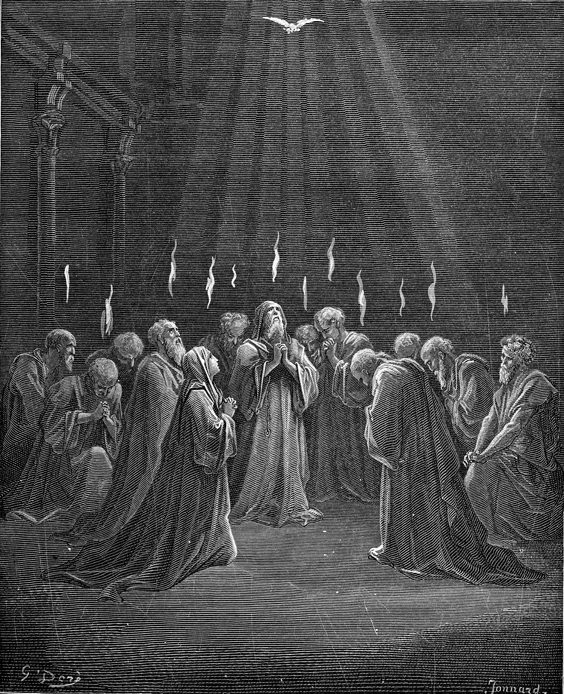This coming Sunday marks the feast of Pentecost. In connection with that, I am posting a substantially revised version of an offering of mine at this site some years ago. As I’ll suggest, the astonishing events that we read about on that first Pentecost were, at one time, regarded as even more critical than we now think of them. Specifically, I will argue that when early Christians first told that dramatic tale, it was as a Resurrection appearance, just as clearly so as the better known stories that we tell around Easter time. The whole phenomenon raises fundamental issues of definition and understanding, and above all in how we think of that idea of Resurrection.
When scholars look at any ancient religious work, they are well used to the idea of traditions and legends building up over time, as stories are retold. The assumption is that, the further we stand from a historical event, the more embellished it becomes, and that is generally a reasonable statement. We pay far less attention to another process at work in making our scriptures, which is that of historical amnesia. Even with a religion like Christianity, with so many scholars over time seeking every little titbit that could possibly claim historical validity, some truly major phenomena have simply dropped out of sight, and are seemingly beyond recovery. That has to teach us humility about the prospects for ever writing a history of the earliest Christian movement. We have forgotten so much, probably irretrievably. That includes what at the time were regarded as sensational manifestations and proofs of the truth of the Christian message. Other such events have been utterly transformed in historical memory.
What the Jerusalem Church Believed
As a case in point, I turn to the famous list of Christ’s Resurrection appearances from 1 Cor.15: 4-8. Jesus
was raised on the third day according to the Scriptures, and that he appeared to Cephas, and then to the Twelve. After that, he appeared to more than five hundred of the brothers and sisters at the same time, most of whom are still living, though some have fallen asleep. Then he appeared to James, then to all the apostles, and last of all he appeared to me also, as to one abnormally born (NIV).
The exact chronology here is fairly clear. Paul is writing around 50 AD, at least twenty years before the earliest canonical gospel was written. (The source Q might have been starting to accumulate around this time). The crucifixion occurred around 30, with Paul’s conversion a few years afterwards, and he picks up this account in Jerusalem in the mid-late 30s. All the events reported here, all the appearances, occurred between 30 and 35. Taken together, this is the bedrock of the Christian faith as proclaimed by the apostles. This was the array of proofs and evidences on which Paul and his contemporaries based their evangelism.
I highlight this passage as a near-incredible survival within the New Testament. The vast majority of what we find in the gospels records events from a perspective of several decades later, after a great deal of reflection, interpretation, and theologizing. That is not to say they do not reflect actual words or deeds of Jesus, but there is a great deal of room for debate. This 1 Corinthians passage must reflect what the church leadership thought and believed within – at most – five or so years after the Crucifixion. It has some claim to rank as the most important single text in the whole New Testament.
If you break down the events described, you find a total of five original statements of appearances, with the final clause being added by Paul himself. These events – these Five Pillars – are presented in a clear sequence: this happened, then that happened, and after that, something else. You will also notice a pretty total mismatch between that sequence and the narrative offered in any of the four canonical gospels. Look what is not mentioned at all. There is no Mary Magdalene, no holy women, and no Road to Emmaus. The changes are enormous.
Just to divide these appearance stories into separate episodes, and how they are or are not recorded in the New Testament:
1.he appeared to Cephas, [John 21; Luke 24.34]
2.and then to the Twelve. [John 20. 19-22, Matt 28. 9-10, 16-20; Luke 24. 36-39. Possibly other passages as well?]
3.After that, he appeared to more than five hundred of the brothers and sisters at the same time, most of whom are still living, though some have fallen asleep. [not in any canonical gospel, in exactly those terms – but see below]
4.Then he appeared to James, [not in any canonical gospel. It is however a major feature of the now-lost Gospel of the Hebrews, which appealed to Jewish-Christians, and which enjoyed high respect in the mainstream church until at least the fourth century. Jerome quoted it: “He took bread and blessed and brake and gave it unto James the Just and said unto him: My brother, eat thy bread, for the Son of Man is risen from among them that sleep.”]
5.then to all the apostles [?not in any canonical gospel? Possibly Acts 1.1-11? I’ll return to this point below]
Paul’s addendum: and last of all he appeared to me also, as to one abnormally born [Acts 9]
To illustrate the disconnect from the canonical gospels, we might take the initial appearance to Simon Peter , which the I Corinthians account regards as critical and transformational. But where is that recounted in the canonical gospels? It is present, but marginalized. Read Luke 24.34 and that proclamation about Christ appearing to Simon/Cephas, and then try to determine from the text exactly where that amazing event is supposed to have happened. As we have it, John’s gospel explains just how Jesus did not initially appear directly to Peter (John 20.7-10) – but then follows with the appearance to Peter in his chapter 21. As I have suggested, this last is a vestigial survival of the original and primitive account of a Resurrection appearance.
More Than Five Hundred
Let me focus here on the sensational appearance to the “more than five hundred,” epeita ophthei epano pentakosiois adelphois ephapax. Just to repeat a common complaint about translation, the passage does not say that Jesus “appeared,” but rather that he “was seen by,” ophthei, which is more passive. The emphasis is on the experience of the audience, not the intent of the appearer.
Some scholars think that Paul added a couple of words to the original statement, particularly “more than” and “at the same time.” But I do wonder about that ephapax, “at the same time.” I should say that ephapax is an odd word, and for whatever reason, Paul rarely used it otherwise, nor its cognates. This is of interest because writers tend to favor or dislike particular words, and their habits in that way are often a guide to the authorship of texts. On balance, then I really don’t think Paul invented or inserted the word.
For present purposes, it does not matter whether the appearance to the five hundred was historical in the sense of being an actual appearance by the risen Christ. Paul’s statement shows that such an event, such a massive “seeing” or collective vision, was believed to have occurred, and that it was widely reported by people who claimed to have participated – certainly dozens, perhaps more. Otherwise, his statement would have been mockingly rejected by anyone who knew the church’s authentic history. Surely, such a listing of witnesses represented a kind of credal statement used in early preaching. Five hundred people saw this in one place and at one time! How can you doubt it?
Where and When?
This appearance must have been a spectacular event, one that cries out to be the climax of some Biblical epic. It could not be interpreted as the mystical insight of a lone believer mulling over the meaning of Jesus’s life. Somehow, we must believe, several hundred people assembled in one place believed they were sharing a vision of the Risen Christ. At the time, that must have represented a major proportion of all the Christian believers on the planet. As to location, it is difficult to imagine it occurring anywhere else than Jerusalem, but one of the provincial cities of Galilee is just possible.
But our uncertainty about location points to an amazing fact, namely that at least in those precise terms, this event is not recorded in the New Testament or the Apostolic Fathers, nor in any alternative gospel or Gnostic text. In terms of early sources, the only vague candidate for such a mass appearance is the Pentecost scene in Acts 2, which as we know it today is not explicitly cited as a Resurrection appearance. But as I will suggest, that is what it was originally.
The differences between the early creed and the Acts passage are evident. That takes me back to the original point about how stories evolve and grow over time. We can well imagine how an original story might have told how a group of Spirit-filled apostles preached successfully to large crowds, and that over time this mutated into a colorful legend of a direct appearance by Christ himself. Is it likely, though, that the process might have traveled the other way, that Luke might have purged or toned down an original Resurrection appearance in order to make the Pentecost narrative as we have it? Would he really have removed the Risen Jesus himself from such a story? Would he have transformed a reported Resurrection appearance into a sermon? Surely that is unlikely.
But then think through that Acts scene in detail, and the resemblances become clearer. The 1 Corinthians account speaks of five hundred “brothers and sisters” (adelphois), which suggests an appearance to an already faithful group. As we have it, Acts described the large crowd as initially non-followers, civilians. At the end of the story, however, they are indeed converted, to become brothers and sisters. Reputedly, three thousand in all are converted thus, which is not exactly five hundred, but only a fool worries about precise numbers for large crowds in ancient sources.
How the Resurrection Idea Evolved
All that is really missing here, then, is a Resurrection appearance, which is a very big absence, until we ask: how did those ancient believers conceive of such a thing? We are used to the very material imagery presented in the later gospels, the kind of portrayal of a visible, living, breathing individual that you see in millennia of painting and in modern media – the kind of Resurrected body that sits by fires and eats fish.
But another tradition suggests how Jesus could be “seen” by someone, the non-material and not obviously physical presence represented by the famous passage about “where two or three gather together in My name, there am I with them.” Now look back at the start of Acts 2, where the Holy Spirit famously descends in tongues of flame. This is an era long before the development of the idea of the Trinity, a time when conceptual distinctions between Christ and that Holy Spirit really did not exist. Would the Acts account not be a natural way for early stories to tell of a vision of Resurrection, what we would call a Resurrection appearance? That scene leads directly to the preaching to the Pentecost crowds, and mass conversions. It meshes very well with the sequence portrayed in that truly primitive account, that Jesus appeared “then to the Twelve. After that, he appeared to more than five hundred of the brothers and sisters at the same time.”
So why did Luke not report the two interlocked events as a Resurrection – the tongues of fire, and the Pentecost preaching? A couple of possibilities suggest themselves. One is that, over the intervening decades, that element had dropped out of the story. Do recall that Paul was writing to the Corinthians at a time when Jerusalem still stood as it had in Jesus’s time, and a great many people could still transmit information about what had happened during and after his lifetime. All that changed, catastrophically, after the Jewish war that raged from 66 to 73, which must have eradicated most of those traditions. By the 70s, moreover, most of the first generation of apostles must have died out, and their memories with them. Look what happened to the once-very significant appearance to James. The detailed and famous accounts we have of actual Resurrection appearances date from the 80s or 90s, with the stories in Matthew, Luke, and probably John. All were writing after a watershed event that made it extraordinarily difficult to reconstruct much of the church’s earliest history.
But another possibility is that understandings of Resurrection had changed, almost beyond recognition, between the 30s and the 90s AD. In the earliest days, Jesus followers believed absolutely in the fact of his Resurrection, but this was not necessarily manifested through physical appearances: he “was seen.” As the first century progressed, and as later followers presented their arguments to skeptical Jews and pagans, accounts of Resurrection of necessity became ever more physical and fleshly. By Luke’s time, it has become inconvenient or embarrassing to report an alleged appearance of the Risen Jesus unless it has these physical features. Presumably, the primitive Pentecost story as Luke received it contained no such element. You can imagine the contemporary anti-Christian critics: “What do you mean, you just felt his presence and knew he was with you? He didn’t even say anything? That’s not much of a story!” Hence, Luke reports the crucial Pentecost story, as he must – but his sources did not allow him to present it explicitly in terms of a Resurrection appearance. The Jesus who “was seen” by the apostles has become invisible.
As a case in point, look at the famous Gustav Doré image of The Descent of the Spirit, and ask: where, in this, is the Risen Christ?
You can date this process of “materializing” quite well in the four gospels. As we have it, Mark, writing around 70, has no specific Resurrection appearance (although he certainly would have had originally). Matthew and Luke, in the 80s or 90s, have material appearances, but even here, there are recollections of older ideas. In Luke’s journey to Emmaus, the two disciples don’t even recognize that the person accompanying them is Jesus, until they realize the fact through understanding the scriptures. The realization comes through faith.
John has a couple of different strata of beliefs, with a famous and very physical appearance to Mary Magdalene. But when he reports how the apostles receive the Spirit in John 20, John adds a personal and material Jesus to his story. This scene – which is surely John’s version of the same Pentecost story – features a physical, material Jesus; Luke’s does not. But the author of John is keenly aware that such ideas are at least open to criticism, in the closing years of the first century. Hence the story of Doubting Thomas, who is brought to belief through this material manifestation. We must wonder about the targets of this polemic: they might well have been older-style believers, who still viewed those appearances in less physical terms, and had not come around to the new perceptions and claims.
So, yes, the earliest church did originally believe that the Pentecost story was indeed a Resurrection appearance, quite as much as the meeting with the apostles by the Sea of Galilee. As such, they recorded this Pentecost appearance centrally and prominently in the creed of the 30s that we find in 1 Corinthians. But its concept of Resurrection was not sufficiently physical and explicit for the later generation of the 90s.
It’s not that Luke does not know the appearance to the five hundred: he is just writing in a different world, which demands a more personalized narrative, where Jesus could be a full speaking character.
You may not agree with my interpretation of that Pentecost scene here. But if you don’t, you really need to explain where we would look for that “more than five hundred of the brothers and sisters” apparition, which was obviously so critical to the earliest Christian proclamation. Has it simply been forgotten, lost without trace? What a damning statement that would be about any claims the Christian historical record has to recall the earliest phases of the faith. Of the five components of that original primitive package, we know that one (James) has been lost irretrievably. But has a second? Are we really missing two out of five of those elements? As Oscar Wilde almost said, to lose one fundamental element of a religious creed may be regarded as a misfortune; to lose two looks like carelessness.
I should explain that my interpretation here differs from what I presented in my original column from a few years ago, as I have thought the issues through. Briefly, I used to think that the “more than five hundred” episode was some free-standing event that had been totally lost to historical memory. On reflection, I think it simply has to refer to the Pentecost preaching that we know so well from Acts 2. What I am saying in the present column is now my definitive comment and, as such, it will be unchanging and infallible. And yes, I am joking.
The range of sources on these matters is immense, but the obvious and indispensable starting place is N. T. Wright, The Resurrection of the Son of God (2003).
















